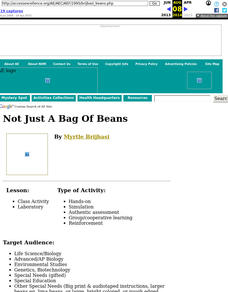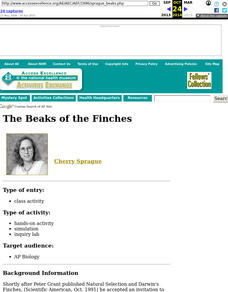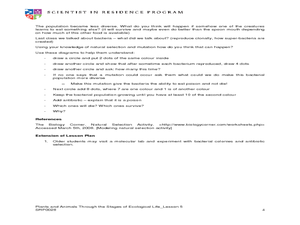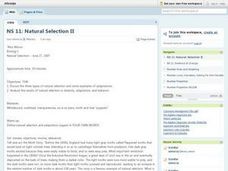Curated OER
Introduction to Natural Selection
Students develop an understanding of natural selection, specifically, how it unfolds from generation to generation. They work in small groups to perform an experiment using beans. They use a worksheet imbedded in this plan to guide their...
Curated OER
WHAT DARWIN NEVER SAW: Evolution, Science, Biology, Natural Selection
Students view video showing recent field work on a twenty two-year study of finch beaks on a small island in the Galapagos, showing natural selection clearly operating in the wild.
Curated OER
Not Just a Bag of Beans
Learners determine the types of natural selection and variation that exists in a population, using beans.
Curated OER
The Beaks of the Finches
Students become birds and are given "beak-types". After completing the simulation, students relate results to adaptations and natural selection. Extensions of the simulation allow for comparative results and include population genetics.
Curated OER
Natural Selection and Evidence Worksheet
Matching and fill-in-the-blank exercises give biology whizzes a chance to practice vocabulary associated with evolution. Terms to be reviewed focus on evidence for evolution, natural selection concepts, and some genetics words. You could...
Curated OER
Classification and Binomial Nomenclature
Students practice identifying different groups of living organisms using a dichotomous key. Students also examine the history of an organism and its lineage by writing a paragraph about it and "three generations" of ancestors.
Curated OER
Evolution Concept Map
In this biology worksheet, students complete a concept mp on the theory of evolution by natural selection. They fill in 8 blanks with the correct terms from the list.
Curated OER
Scavenger Hunt: Simulating Natural Selection
High schoolers simulate natural selection using pinto beans. In this biology lesson, students identify the factors affecting organism evolution. They record data from the experiment and formulate a conclusion.
Curated OER
Peppered Moth Simulation Activity
Students simulate peppered moth predators using SmartNotebook. In this life science instructional activity, students collect survival data and analyze results. They explain the importance of changes in species over time.
Curated OER
Natural Selection: Exploring the 'Ohi'a Common Garden
Seventh graders examine natural variation by visiting the Ohi'a Common Garden in Volcano, Hawaii. In this natural selection lesson, 7th graders study background information about phenotypes, genotypes, and phenotypic plasticity before...
Curated OER
Evolution: Natural Selection
Learners analyze and discuss the evolutionary history of dinosaurs. In this investigative lesson students monitor different organisms in the environment and analyze the pressures that affect the chances of survival.
Curated OER
Populations- The Survival of the Fittest
Students examine the ways that populations become diverse and how mutation changes the diversity of a population. In this exploratory lesson students study natural selection by completing a lab activity and discussing what they learned.
Curated OER
How Evolution Works
Students examine the term natural selection and what behavioral adaptations are. In this evolution lesson students view videos about evolution and perform experiments that simulate populations that interplay between the forces of...
Curated OER
The Theory of Evolution
In this theory of evolution learning exercise, students review vocabulary words associated with evolution including the different types of evolution patters. This learning exercise has 5 true or false and 5 matching questions.
Curated OER
Evolution of Life
In this evolution worksheet, students review the natural selection process and how organisms' adaptations evolve over time. This worksheet has 8 fill in the blank and 11 short answer questions.
Curated OER
The Theory of Evolution
In this theory of evolution worksheet, students will review the role Charles Darwin played in the theory of evolution, natural selection, and adaptations. Students will explore some of the different types of evidence for the theory of...
Curated OER
How Do Species Change?
In this species changing worksheet, students will brainstorm problems that species face in their habitats. Then students will write in the solution for each problem they wrote down in this graphic organizer worksheet.
Curated OER
What Do Fossils Reveal?
In this fossils worksheet, students will write down 4 facts that they know about fossils and then come up with 1 conclusion about fossils based on their facts. This worksheet is a graphic organizer.
Curated OER
The Process of Speciation
Students illustrate the results of natural selection by identifying conditions that could lead to the development of new species (speciation) based on a given description of environmental conditions and description of variation within a...
Curated OER
Natural Selection Foldable
Pupils examine and identify examples of species that developed as a result of immigration, genetic drift, and adaptive radiation. They conduct Internet research and define key vocabulary terms, and use their species example on their...
Curated OER
Pedigrees
Students examine various inheritance patterns using pedigrees. In groups, they predict what might happen to the offspring of a woman with normal vision and carries the recessive allele gene. They determine the genotypes of the man and...
Curated OER
Natural Selection II
High schoolers participate in a discussion about the three types of natural selection. In groups, they identify examples of adaptations from photographs. To end the lesson plan, they analyze results of natural selection in adaptation,...
Curated OER
Natural Selection
Eighth graders define natural selection and adaptation. They simulate natural selection within a species and relate the elements of natural selection to the simulation. They analyze the results of natural selection in terms of...
Curated OER
Natural Selection
Pupils comprehend that natural selectionis the tool for adaptation and evolution of populations. They pick three M&M's and no candy corns. Students tally the number of different color M&M's chosen. They discuss why colors were...

























